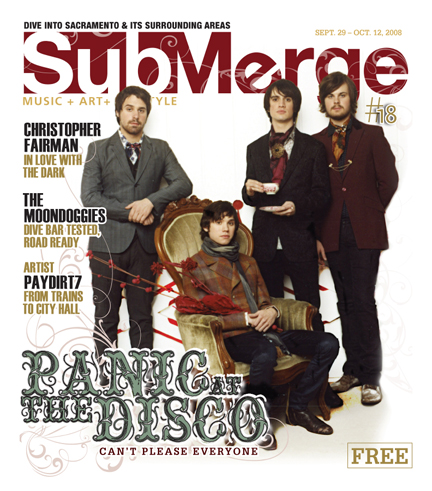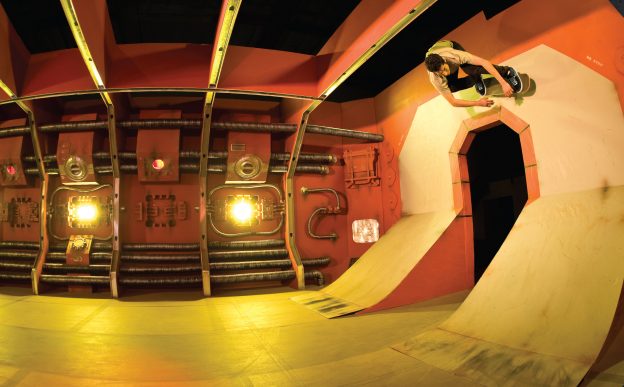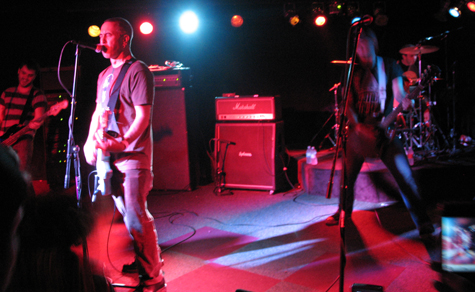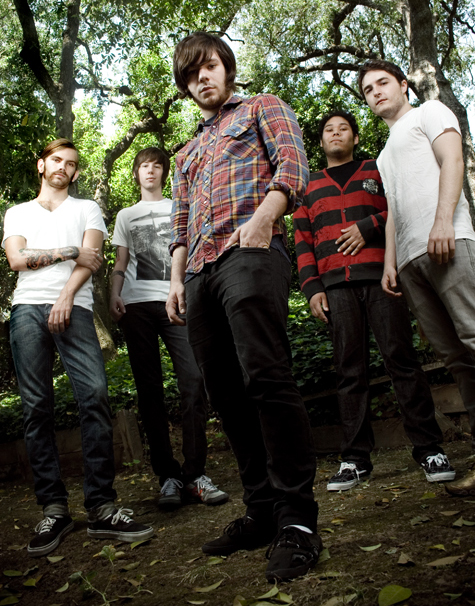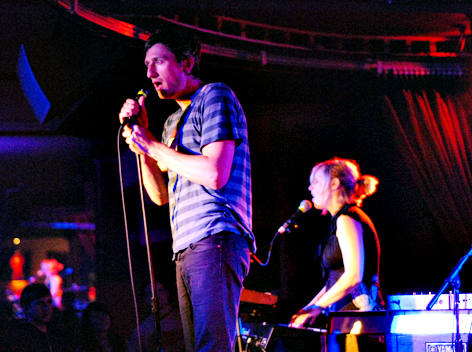Put professional skateboarder Omar Salazar on the phone for an interview, even while he’s in Australia on a Nike Skateboarding team trip, and you’ve got one of the nicest dudes you’ll ever meet; caring, witty and all around fun to talk to. Put Salazar on a skateboard, assuredly where he’d rather be than on the phone, and you’ve got a savage on wheels; a straight-up wild man that charges at his tricks with relentless speed, dedication and concentration. The 26-year-old skater from Sacramento has made quite a name for himself in the industry, especially within the last couple years with his part in Alien Workshop’s video Mind Field, making the March 2009 cover of Thrasher and the announcement from Nike that Salazar will have his own signature shoe. But all the success hasn’t come easily.
Salazar was raised by loving and supportive parents who fled to the States from their home country of Chile. Pursuing a career in skateboarding, though, was not exactly what they had in mind for their son in this so-called land of opportunity. “They were always like, ‘Hey look, you’re lucky you have opportunities here, you need to go to school and you need to work for a big company,” said Salazar of his parents outlook on his skating. I was always like, ËœYeah, but I don’t want to do that; I’m not good at that. This is what I want to do.”
Salazar remembers having to hide his skateboards and boxes of products that companies were sending him so his parents didn’t get suspicious. “I didn’t want to disappoint nobody, but I was never good in school,” he admitted. “I mean, I finished high school, but I was never good as far as book smarts goes, I’m better at street smarts.” Those early years also consisted of a lot of couch surfing, riling up change from said couches to hit up Del Taco, raiding Safeway’s sample tables and bombarding open house food platters. “Yeah, I’ve come a long way,” Salazar said with a laugh, looking back.
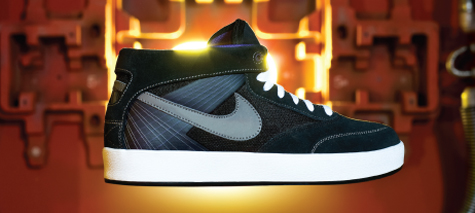
A long way is an understatement, as this month Nike will release Salazar’s first signature shoe, a career milestone for any athlete involved in any sport. Salazar will be the second Sacramento-area skater to get his own Nike shoe, as teammate and close friend Stefan Janoski did so just last year.
“In the beginning,” Salazar remembered, “Before Nike gave anyone shoes, Stefan and I, we’d had offers before in the past from other shoe companies, but I always stick with what I believe in. I believe I’m a loyal rider. That’s just the most important thing. So, I figured if I kept loyal with Nike and the people I work with, then something good was going to happen.”
Even after Nike told them years ago that Paul Rodriguez would be the only team skater to get his own signature shoe, Salazar stuck it out, all the while telling Janoski, “We’re going to get shoes, trust me.” Eventually they both got the phone call and for Salazar, it was sort of an ‘I told you so’ moment when they did.
“I don’t want to sound cliché or lame, but in a way I kind of manifested it because I knew it was going to happen,” said Salazar, not in a cocky manner, but a confident one. “Even before they offered me a shoe, I drew up a design and straight up put one in my room, one in my bathroom and one in my closet.” Salazar would be gone for months on skating trips and he’d come home having forgotten about his dream shoe designs, which re-invigorated him to skate harder, to keep going so that one day it would be a reality. “Like a year later after working hard and having fun skating and stuff, they hit me up and were like, ‘Hey, we want to give you a shoe after Stefan.'”
When it came time to actually visit Nike HQ in Portland, Ore., to meet the people who would be designing his shoe, Salazar was well prepared with his sketches, his favorite color schemes and other things that represented him and his personal style. “When I first started working on the shoes, they were like, ‘Shoot us your favorite colors, your favorite objects, your favorite things around the house, bring us photos of them.’ I didn’t know what the hell they were talking about,” said Salazar. Nike was essentially asking for pieces of Omar so that his shoe “could tell a story.” Turns out, Nike doesn’t just give signature shoes to anyone and when they do, they always have little stamps of the athlete’s personality and style on them. Take for instance Michael Jordan’s famous Air Jordan logo, jersey number, etc. found on his shoes. Salazar wanted a classic-looking silhouette, but with Nike’s new technology infused.
“I’m really into the ’50s and oldies, and I like old tin cans and old rockets and outer space and all that stuff,” said Salazar of some of his personal interests. Hence the reason his shoe features a cool little rocket ship on the sole. Salazar also pointed out that he likes to surprise people, so he told Nike he wanted to make the tongue of his shoe interchangeable. “I wanted to have fun with the shoe and I wanted it to be functional for people,” said Salazar. “Some people like to tie their shoes real tight and some people keep their shoes real loose. Some people like a thin tongue, some people like a real thick tongue,” he said. He also wanted Sacramento-area residents to connect with the color scheme, so he included purples and blacks to match our beloved Kings’ colors.
What really makes Salazar’s signature shoe stand out, though, is the inclusion of Nike’s Flywire technology, something new to the world of skateboarding shoes. Basically, shoes with Flywire are really light, yet really supportive—two attributes not normally associated with one another in the sporting shoes industry. In the past, more material meant more support, but in turn the shoe got heavier. But with Flywire, Nike took Kevlar and spun it into an embroidery-thin thread for reinforcement, and then they added Lycra in areas that needed power and stretch. According to Salazar, they feel great. “Nike’s technology enables the shoe to be lighter and support your foot more and lock it down really well,” he said of the shoe’s feel.
Sacramentans will be able to witness Salazar ripping up B Street Skatepark in his new shoes on Sunday, March 7, at the official shoe launch demo along with Nike teammates Paul Rodriguez, Stefan Janoski, Brian Anderson, Justin Brock, Grant Taylor, Daryl Angel, David Clark, Elissa Steamer and Brad Staba. Anyone who knows anything about skateboarding knows those are some heavy hitters and that this event is will not be to miss. As our conversation was coming to an end, Salazar closed with a bit of advice for the young skaters out there. “The one most influential person that told me how to get shit was John Cardiel, Sacramento’s best skateboarder ever. Whenever I was trying something, just trying for hours and hours, he’d yell out, ‘You’ve got to want it! You’ve got to want it!’ That stuck in my head forever, so if there’s any message I’d give anyone, it’s that.”
Catch Salazar and the Nike SB team on Sunday, March 7, 2010 at B Street Skatepark. Demo starts at 2 p.m.
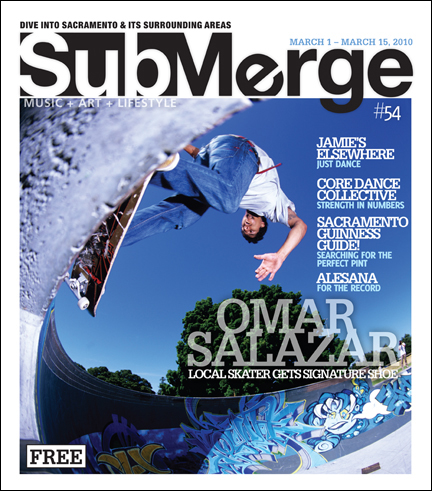
Cover photo by Jonathan Humphries
Youth Brigade (Jan. 29, 2010)
Local rock ‘n’ roll club with rich history is brought back to life, again
“John, don’t let the club burn down.” That’s one sentence that Sacramento-area resident John Webb will not soon forget, especially as the seminal club he watched burn more than 30 years ago prepares to be resurrected yet again.
It was a late night on May 27, 1977 and Webb was closing up shop at the Shire Road Pub in Fair Oaks, a rock ‘n’ roll club that he and some high school friends had opened four years prior. The club’s owner, Gerald Sterchi, was on a motor home trip to Canada and had left Webb in charge. It was a Friday night, one of the venue’s busiest. The band had finished up and the crowd of drunken patrons had cleared. Webb went about his normal closing routine: He cruised through the club, checked all the bathrooms, walked into the band room and made sure everybody was out. Everything looked perfectly fine, just like at the end of every other night, so he hopped in his car and made the long drive back to his home in Folsom.
Webb had just gotten home at about 3 a.m. when the phone rang. He answered, only to hear someone from the fire department speak the dreaded words, “The club’s on fire!” Webb jumped back in his car in disbelief and raced back down to the club. He was driving so fast, in fact, that he got pulled over by the Folsom police. The officer let him go, of course, once he heard Webb yell, “My club’s on fire, my club’s on fire!” But by the time he got back to the bar, it was too late. “I couldn’t do anything but watch it burn down,” Webb said. “They were fighting it, but it was pretty well gone. It pretty much totaled the place.” The club he had helped build with his own two hands burned down right in front of him. “It was devastating. Especially since I was told not to ‘let the club burn down.’ Honest to god, that’s what [Sterchi] said to me before he left,” Webb remembered with a good chuckle.
After the smoke cleared, Webb and his associates learned the official story from the fire department. A smoldering cigarette left behind on the couch in the band room had started the blaze. It was indeed a tragedy; Sacramento had lost one of its most happening rock ‘n’ roll clubs. It was the place where 1960’s pop band The Beau Brummels, after having been broken up for eight years, recorded their Live! album; the place where Webb snuck beers to a then-19-year-old local guitar shredder named Craig Chaquiço, who later went on to play in Jefferson Starship; the place where Webb had booked a “little-known band out of the Bay Area for $500 for two nights” called Pablo Cruise, who later went on to have huge commercial success with songs like “Whatcha Gonna Do?” and “Love Will Find a Way,” both of which charted in the Top 10 in 1977 and 1978, respectively. “It’s hard to describe the time that we had there,” Webb remembers of those years spent at the club. “It was a really magical time.”
Fast-forward about five years to 1982. Webb, who obviously was out of a job after the club burned down, had started his own talent agency called Star Attraction and was booking all of the hottest local bands in nightclubs all over Sacramento and Stockton, even Reno, Nev. Sterchi, meanwhile, was dead-set on re-opening Shire Road Pub and ultimately did so in a building on the corner of Auburn and Garfield that had previously housed a bar called Froma’s.
“Geri came to me and he wanted Star Attraction to book the club, so I did that for a few months,” Webb remembers. “Then, he said, ‘John, I’d like for you to come back and run the club for me.'” So Webb did just that—he went back to the club and ran it for Geri and his wife, Karen, just like he had all those years ago at the original Fair Oaks location. He stayed there and managed the place until 1987, when he retired from the entertainment industry.
This new incarnation of the Shire Road Pub also served the Sacramento rock community well, but the music scene was drastically different than when the original club was around. “The rock scene was going largely toward VJs and DJs and getting away from the live music, and music was just changing,” Webb says. “It was going more toward hip-hop and the whole live music scene was slowly dying. We had had about 25 years’ worth of a run and we thought that was pretty darn good for a rock club.”
The Shire Road Pub version 2.0 eventually closed its doors in 1994 and soon after became a strip club called The Body Shop. Don’t think of it as inferior to its predecessor just because it didn’t go out in a blaze of glory; there were some noteworthy bands that played there too. Take, for instance, the hard rock band now known around the world as Tesla, who still called themselves City Kidd when they played the pub; or Steel Breeze, a band from Sacramento whose 1982 single “You Don’t Want Me Anymore,” out on their self-titled RCA Records debut, made it to the Top 20 on the charts. It was a hot spot for up-and-coming local bands like Target and 58 Fury, which featured longtime local musicians Darin Wood and Joe Johnston (who now runs the popular recording studio Pus Cavern). “I remember playing four sets of mostly covers on Sunday and Monday nights,” Wood recalled of the Shire Road Pub. “Kenny Nicholson, the house sound guy at the time, would tell me, ‘You got to talk more in between songs, say some shit. I don’t care if you read the newspaper, just say some shit!'”
George Gosling, a music buff who helped run an artist management company at the time called Pyramid Productions, remembers showcasing bands at the club’s second location. “I did a U.S. debut of a Canadian band that I managed called Stonebolt,” Gosling recalled. They were from Vancouver, had a record deal with a subsidiary label of Casablanca. We did a big party on the opening night and many of my family members, friends and associates were there.” Stonebolt, just one week later, went on to Hollywood to showcase for Billboard, Cashbox, Record World, Variety and the entire Casablanca staff. Yes, the Shire Road Pub was surely a special place that many Sacramento rock ‘n’ rollers remember fondly and miss dearly.

Tom Kimble, owner of the Kennel Club (aka Doghouse Saloon), also on Auburn Boulevard, is definitely one of those guys. When Kimble got word that The Body Shop was closing down last year, he made some calls and was in contact with the building’s owner the next day. He told him about this great idea he’d had to turn it back into the rock ‘n’ roll club that everybody remembers, only this time a little different: the club would be an all-ages venue, with no alcohol available. It took a few visits to persuade the owner, but eventually he saw Kimble’s dream.
“It was important to me,” Kimble said of bringing back the rock club in the same building. “When I walked in there I still pictured what it used to look like.” According to Kimble, the Shire Road Pub was the place to be. “I used to go there all the time,” he remembered. “You couldn’t get in that place on the weekends, it was really happening. If we couldn’t get in, we’d wait. It was always packed, and very loud.”
And so with the owner of the building’s permission, Kimble got to work on the new Shire Road Club (the word Pub got changed to Club since they aren’t serving alcohol). “I can’t put it back exactly the way it looked,” Kimble said of re-piecing together one of his favorite extinct rock clubs, “But I can get it close.” Kimble and a small group of friends and helpers are still trucking along; even as of press time for this issue they were laying carpet, painting walls (local graffiti artists are scheduled to customize the inside of the venue with rock-themed art), setting up stage lighting and basically working their asses off to get everything set up for their first official show on Jan. 15, 2010. It’s hard work that these guys seem more than willing to do for the area’s live music fans, especially the younger ones that so often can’t enjoy a show because it’s at a bar.
Making sure the new Shire Road Club is an all-ages venue was very important to Kimble throughout the lengthy, tiring feat of remodeling and re-opening a venue. He’s spent many years dealing with drunken band members and angry patrons at his bar/venue the Kennel Club, and he’s quick to point out how old that gets. He’s not worried about dealing with hordes of punk rock kids, though, who are typically stereotyped as “bad kids.” He’s got a different outlook on that whole crowd.
“Just because a kid wears a leather jacket with spikes on it, he’s not a bad kid, that’s just what he’s wearing.” Kimble says, “I want to have an all-ages venue where they can enjoy the music that they know and the music that they wrote. Let them express themselves. It isn’t about me dude, nobody gives a shit about the club owner, it’s about the kids. If the kids are happy and they have a place to go, I think I’ve accomplished what I wanted to do.”
In 2008, when fashion designer Traver Rains’ highly acclaimed label Heatherette started to dissolve around him and then-boyfriend/co-designer Richie Rich, he found himself tired and torn. For nearly 10 years, he and Rich had built an empire; their eclectic, unusual designs were seen on countless celebrities and famous models on runways, in magazines, on television and in movies. The two traveled the world together showcasing their work at upscale fashion shows and hosting celeb-studded events and parties—basically living like rock stars. Rains guest judged an episode of Project Runway and appeared on America’s Next Top Model. You get the idea—Rains and Rich were, and still are, a big deal in the fashion world. Because of his success with the Heatherette label, many in the fashion scene expected Rains to dust himself off and jump right back on the horse immediately after it shut down, but he had other plans.
Rains began using his newly acquired free time to focus on another passion, photography. This familiar outlet of artistic expression (he spent his fair share of those 10 Heatherette years at photo shoots) soon influenced the launch of a T-shirt line called T-Rains. His photography and new line are heavily intertwined and feed off each other creatively, as you’ll see in the following interview. Rains will be in Sacramento on Dec. 17 at the Haute Holiday Gala hosted by International Academy of Design and Technology, giving us a chance to view his impressive work in person.
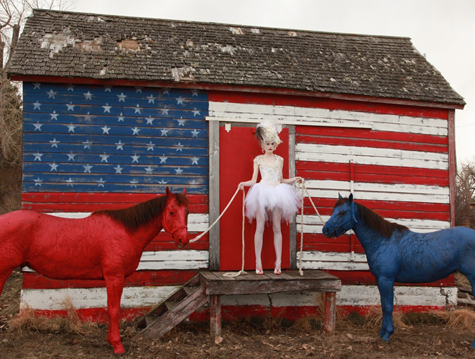
How serious do you take your photography? Would you say it’s your main focus now?
Yeah it’s my main focus right now. I’m having a lot of fun with it.
Do your design work and photography feed off of each other creatively?
Yes definitely, that’s sort of the point to the new T-shirt line is to have the connection between the two. I spent nearly 10 years in New York doing Heatherette and a lot of that time was spent on photo shoots, and that was always a fun part of the design process. I learned a lot being behind the scenes and seeing everything that goes on. After we wrapped Heatherette up, I kind of felt like I had grown up on a photo shoot”¦ I was a little bit tired of the whole fashion/design aspect of everything, so it was just sort of a natural transition. Another thing that sort of inspired me was going back home to Montana, and we have a big horse ranch and on the property there’s these amazing old buildings from the settlers and they’re all sort of collapsing and falling down. I sort of wanted an interesting way to capture them, so I flew in a model and a hair and makeup team and that was sort of my first endeavor behind the camera. I started thinking of the images I had taken on T-shirts and sort of just out of habit, I guess, I stared making them. I decided I could try and tie the two together, instead of sell the photography as a picture, sell it as art on a T-shirt.
I’m looking at a few of those photos from Montana, and they are beautiful! When was it? It looks like it was cold.
It was springtime, and the poor girl was freezing.
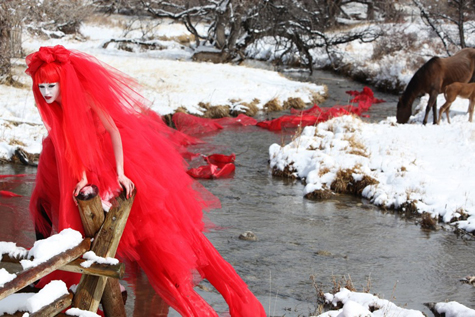
The one where the woman’s red dress is flowing down the creek behind her, how did you set that up? Was that photo pre-meditated or did it just happen?
Yeah, I kind of had that image in my mind for a couple of months. The dress is made up of like two hundred yards of that red material and most of it is all connected to the train of the dress. And so even though the creek wasn’t moving very fast, it was still so much fabric that it was pulling her off of that ledge. She was in heels and there was snow and ice everywhere.

Horses show up in a lot of your work. Are they a big inspiration for you?
Yeah, I basically grew up on the back of a horse. I had a pony before I could walk. So yeah, the western thing has always been really important to my whole vibe. I wear a cowboy hat and boots everywhere still; I just grew up that way. I like the leather, the rough-and-tough feel, even my T-shirts I’m sort of adding that into them.
The Heatherette label that you ran with Richie Rich has been inactive for some time now. Do you miss it?
Oh yeah, definitely. It was the best experience. We did 16 New York fashion shows and then we did almost another 20 around the world, everywhere from like Russia to Austria to Miami to Los Angeles. All those photo shoots and celebrities—it was amazing and a lot of work.
What was it like when famous models and celebs were wearing your designs on the runways, in magazines, on television—it must have been like a dream come true!
Yes, I always was pinching myself. Always.
Do you and Richie still stay in touch?
Yeah, we’re completely on great terms. I see him every once in a while in L.A., and he’s still running around like crazy, so we don’t chat every day or anything.
Do you find now that designing as a one-man team, as opposed to a duo, is easier? Harder?
It’s different; working with another person is easier because you have somebody to help you out and you always have to give and take and collaborate. I definitely couldn’t have done what I did at Heatherette without Richie involved. I learned so much from that, that working alone isn’t that tough. I kind of know the ropes now. I’m just re-starting out really slow; I’m not going to go into any mass production thing right away. I want to keep it sort of artsy and small for a little bit. Also, I don’t want design to take up so much of my time that I can’t do these photo shoots.

Traver Rains’ work was displayed Dec. 17, 2009 at the Haute Holiday Gala sponsored by the International Academy of Design, Sacramento. IADT is located at 2450 Del Paso Road, Suite 250, Sacramento. For more information, visit iadtsacramento.com
Dance Gavin Dance Has A New Line-up, A New Record and Big Summer Plans
Dance Gavin Dance has seen more roster changes than an MLB team. It’s tough to pinpoint why the Sacramento-based post-hardcore band has had a tough time keeping members, but one thing is for certain: it never slows their tremendous momentum when someone leaves. If anything, it further fuels the fire lit within their fixated fans, who cause a ruckus on Myspace pages, Twitter updates and message boards. The band owes a lot of their success to the Internet and their young, tech-savvy fans who never hesitate to turn to their computers, iphones and Blackberrys to show their undying love (and, in many cases, hate) toward the band.
With their third full-length album (Happiness, due out June 9), a new lineup and the entire summer spent on Warped Tour to look forward to, the band seems very happy indeed with where they are. Submerge recently sat down with guitarist/co-vocalist Will Swan during a rare break from touring to chat about the new record, hitting the road and their dedicated, albeit crazy, fans.
I got a copy of Happiness to prep for this interview and I must say, it sounds a lot different than previous material.
It always does; every new record is way different than the one before.
Is that something you go for consciously?
I just want to write whatever comes out. Being the main writer, I try not to have an agenda. So every record, I feel, is just a natural progression. This is just what we were feeling at the time.
The guitars seem less distorted and sound much clearer. Can you talk about that?
We wanted to get a really clear tone so you can hear all the riffs. It’s more like a classic rock tone.
Rhythmically speaking, it seems groovier and almost dance-y at times too.
Yeah, I wrote “Don’t tell Dave”—it’s song number eight, the like, dance-funk song—while we were on tour with Senses Fail. I recorded the drums, bass and guitar. I just wanted to play it with the band [laughs] and they were down, so I taught them the song. It just kind of came together. I was really happy to be able to put it on the record. I have lots of funk influences; I like George Clinton a lot. There’s definitely a lot of funk that came through on this record.
You took over the screaming responsibilities after John Mess left the band. Is that something you’re comfortable with?
You know, at first I didn’t really like it. I’ve gotten a lot more comfortable and better at screaming. On the new record, being able to write my own parts and now being able to perform those songs, it’s a lot better feeling than playing someone else’s stuff.
Would you say Happiness is your best material to date?
Yeah, well of course, I always like new stuff [laughs]. I do hardcore comparisons between records. I feel like this one is the most cohesive vocally. Me and Kurt [Travis, lead vocals] worked together to try and come up with actual themes. We worked more together as one.
There’s one part on the record that really stood out. Who is that rapping halfway through the song, “Powder to the People?”
That’s me.
No way! It doesn’t sound like you at all. How did that idea come about?
Everyone keeps telling me that; I had to lay something over that song and I didn’t really know what yet. I got to the studio and our producer calls me and says, “I’m not going to be there for half an hour.” So I just sat there and listened to the song and thought, “What can I even do here? Rap might work!” So I just wrote the rap right there and when our producer got there I laid it down and he liked it. That song was already so weird I thought it would be cool to do something off the wall.
Another track I’ve been curious about is, “I’m Down with Brown Town.” What does that song title mean?
It’s got a couple meanings. It’s a heroin reference; it’s also an anal sex reference, it just kind of came about. While Kurt is singing, “I’m down with Brown Town“ [on “Nasa,” the track leading up to “I’m Down with Brown Town”], I’m screaming, “it’s only seconds away,” then the next song starts.
So you’re foreshadowing the next song?
Yeah, exactly. But kids online have no idea; they are all confused. Then “I’m Down with Brown Town,” the actual song, has another heroin reference; it’s like the heroin section of the CD. None of us have had a heroin problem, but we know people who have. Those songs kind of tie together both musically and lyrically.
You guys will be shooting a new video soon. What song will that be for and can you hint at the treatment?
Yeah, up in Portland. It’s for the song “Tree Village.” We’re doing all our stuff in one day, then there will be other shoots for the story while we’re not there. So we’re going to go up there and do what we got to do. The treatment for the video, I’m going to keep that under wraps. It’s a weird, kind of abstract treatment. It’s more visual; you’d have to experience it. Anything I said about it would just be like, “what the fuck?”
You’re doing a couple weeks with The Audition and Closure in Moscow leading up to Warped Tour. Are you looking forward to the summer?
Yeah, for sure. I cannot wait to go on Warped Tour. We’ve never done Warped. We played it once in Sacramento, on the Ernie Ball stage. It was fun; we had a good crowd. If we have a crowd like that every day, it would be great.
Your lineup has changed again recently. Are you confident it’s solid now?
Yeah, I think so. I always feel pretty solid about it, though. [laughs]
After perusing your Myspace comments, message boards, etc., I’ve come to the conclusion that you guys have some crazy fans. Why do you think so many people love to hate you guys?
[Laughs] The Internet is just a place for people to complain. They don’t even understand. I try not to pay attention to anything anyone says anymore. Our fans are so crazy. I cut my hair, because it’s getting hot you know? And I’ve been getting a ton of shit for it. Kids are like, “Why did you cut your hair?”
Yeah, you had quite the afro going on. So they’re missing it?
Yeah, they totally are!
Not What You’d Expect
Long before Sarah Palin stepped into the national spotlight and gave the small town of Wasilla, Alaska a name, John Baldwin Gourley of Portugal. The Man called it home. “It’s such a sheltered place,” recalls the singer/guitarist/songwriter. “It’s so very much a part of the United States and so very different at the same time.”
Gourley admits that growing up in such a non-traditional environment has had a strong influence on the music he writes and the action he takes. “It took leaving the state and then coming back for me to say, ‘Fuck man, we just need to make a band that’s fun for us. We need to make music that we want to make.”‘
It’s safe to say that for the last few years Portugal. The Man has indeed made the music they want to. Their three albums (and multiple EPs) sound like they came from different bands, an obvious consequence of the group’s insatiable hunger to create something unique, to constantly tread new waters. Their latest effort, entitled Censored Colors, is 15 tracks of genre defying art-rock that has two well-defined movements and an “intermission” in between. It’s intended to imitate the experience of listening to the two sides of a vinyl record, something that Gourley prefers when listening to music. “Everybody has moved into the stage of MP3s and disposable bands and disposable music,” he admits. “It’s so much better to have something that you can listen to as two separate pieces. It’s more like having two albums to listen to.”
Currently in the middle of a two-month-long headlining tour, Gourley graciously took some time to talk with Submerge about the tour, Censored Colors and the recent election.
Where are you at this exact second?
We’re in Chicago. I just went into a shop to get out of the cold. It’s really fucking cold.
You’re probably somewhat used to that being an Alaskan boy and all.
[Laughs] You know, the thing that’s so funny that I always try to explain to everybody that nobody seems to get is it’s so much different, it’s such a different cold. The lower 48 is kind of a wet cold, more than the Alaskan frozen north. Dry cold is so much easier to deal with.
How has the headlining tour been treating you so far?
It’s been going really well. Earl Greyhound and Wintersleep are both really, really great bands. It was really good that it ended up being that way. You never really know when you go on tour. I mean, how many bands have we listened to over the years that we thought were really great and then you go to a show and it’s like, “Well fuck, not good!”
Tell me about your latest release, Censored Colors. It’s different from anything you’ve done in the past. Did it turn out the way you intended it to?
I don’t think a single record we have done has ever turned out the way we expected it to. It’s a good thing. We go through everything making a pretty conscious effort to make a different record each time; that’s important to us. But yeah, it came out the way it was supposed to. It was a record for family, and it was about respect and community and just about life, you know?
And you released it through your own label, right? It must feel nice to be free of a record labels constrictions and own your rights to everything. Will you continue to self-release stuff?
I suppose so. It kind of depends where everything goes. We never like to set any goals or expectations [laughs], we’re just going to do what we’re going to do. We’ll always make records and hopefully do at least one a year as long as the music is there.
Do you think it’s important to put out music that frequently?
I suppose it is. When you’re in a band, that’s what you do. You can’t expect to get better and progress if you’re putting out a record every two years. You can write an album based on a week of your life. You don’t need that space and that time. It’s just what we do. With everything we do, we always want to work hard at it. We’re already planning on going into the studio this December and January to do a new record. Our goal has always been to just make music and keep it moving. Hopefully we’ll get two records out next year, I would love to do that.
I want to switch gears for a second. You’re an outspoken political person with strong views; tell me how you feel about the results of the election?
I’m so proud. I feel like thing’s could go so well. He’s [President-Elect Barack Obama] really just got to take this and run with it. There’s no looking back. He definitely does need to bring the country together somewhat by just proving himself, he’s just got to get out there and do it. He’s got to just say, “Fuck it” to everything that’s going on right now and take it all in. He’s got a lot of work, you know? You can’t expect it to just happen overnight. It was definitely a huge step for the world.
Agreed. To wrap things up on a lighter note, you guys are constantly touring all over the world but do you think Portugal. The Man will ever actually play in Portugal?
[Laughs] Oh man, I imagine at some point. For some reason we haven’t had the opportunity. We definitely got to find some time to do that.
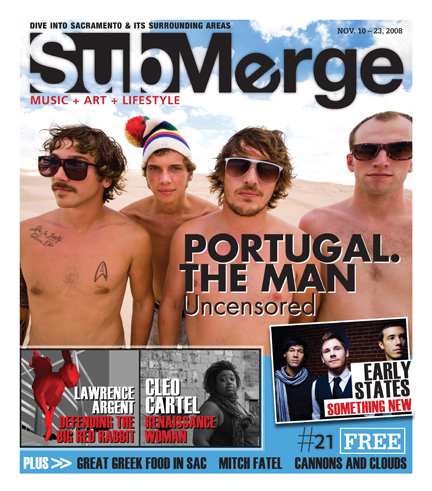
Harlow’s Sacramento
Monday, Oct. 6, 2008
Upon entering the dimly lit Harlow’s Restaurant and Night Club last Monday, I was delighted to see that Two Sheds had been booked as the last minute opener for Mates of State. I immediately noticed that it was not only Caitlin and Johnny Gutenberger (who make up Two Sheds) occupying the stage; there was another women sitting in-between the two assisting with vocal harmonies and light percussions, including the tambourine. I later came to find out that it was none other than Amber Padgett of the local duo Spider Silk Dress. Her addition was a great one and Two Sheds entire set was fantastic, but it seemed like the majority of the crowd didn’t care because almost everyone was talking—so loud in fact that it was nearly impossible for me to really focus on the music. Maybe I chose a bad spot to stand (I do that sometimes), maybe they weren’t there for the opening band, but come on people, show the band some respect and shut the fuck up for a few minutes. My guess is that the lack of bass and drums during Two Shed’s set made it easy for the audience’s short attention spans to become even shorter. What a shame.
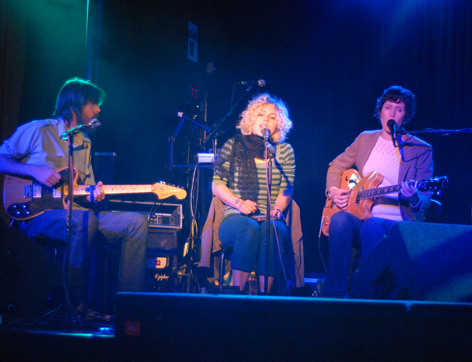
As soon as Mates of State took the stage my theory was proven correct: all it takes is loud drums to get people to shut their yappers (probably because they can’t hear each other talking) and actually focus on the music. As if they were trained to do so, the entire crowd stood up and rushed toward the stage to get a closer look at Kori Gardner (keyboard/vocals) and Jason Hammel (drums/vocals). The two are married and have been making records and touring together since 1997, so they are solid as can be. The chemistry between the two on stage was something I have never before witnessed; you could sense them communicating while playing. They would cue each other with tiny glances or facial expressions to change parts or bring a song to an end.

Their timing and harmonies were flawless, further proving another theory of mine that every married couple should just make music together instead of making babies. When the two would simultaneously sing complementary vocal melodies it was so layered and sounded so huge that it was hard to believe only two people were on stage. At a couple different points during their set, two other musicians joined them: one played cello, adding a very symphonic, cinematic feel and the other played electric guitar (which wasn’t even really noticeable in the mix) and messed around on a laptop playing loops and samples here and there.
Crowd favorites of the night seemed to me to be “Fraud in the ’80s,” and “Like U Crazy,” both off their ’06 release Bring It Back, and “The Re-Arranger” which is on their newest album Re-Arrange Us and on this particular night brought their set to an end (before the obligatory encore of course).
As the show came to an end we quickly guzzled what remained of our beers and stumbled out the door, satisfied with the performances of both artists.
Out With the Old
Photos by Tim Zimmerman
Forget everything you know about extreme sports films. Professional snowboarder Travis Rice’s highly anticipated new movie, That’s It, That’s All, is finally out and the industry will never be the same. For two years, producers Rice and Curt Morgan scoured the globe in search of perfect conditions visiting New Zealand; Japan; Germany; Canada; Valdez, Alaska; Jackson Hole, Wyo.; and Mammoth, Calif. The fruits of their labor is a truly groundbreaking film.
Both the level of riding and the level of production are unprecedented. The film was shot entirely in high definition using a dozen different types of cameras including, for the first time in a snowboard film, the Wescam 35mm to catch steady shots from on-board a snowmobile and the Cineflex HD to capture steady aerial shots from a helicopter. The result is an awe-inspiring Planet Earth-meets-epic snowboarding film. Submerge recently caught up with Rice from his Jackson, Wyo. home to chat about the new film.
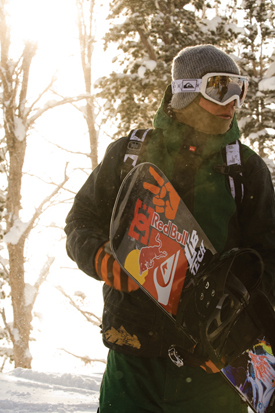
How have the premiers been going so far; you’ve had a bunch, right?
Yeah, we’ve had quite a few. We did a world premier down in Wanaka, New Zealand, and then did a tour through Australia and then we just finished our US Tour. Next Wednesday we’re heading over for a fucking death march through Europe.
I’ve read in a past interview that you still have videos of you and your friends filmed on shitty old VHS cameras riding in the back country when you were kids. It’s got to be a trip to watch That’s It, That’s All now that it is completed. Your films have obviously come a long way.
[Laughs] Yeah, I’m still excited about it and I’ve seen the movie God knows how many times, not to mention being in that editing room for about four months. Seeing people watch it though, they are genuinely stoked on it. I’m still hyped on the film.
Don’t you think you just made every other snowboard video dropping this year look like clown shoes?
[Laughs] Um, I mean I definitely don’t like to say it that way. We were definitely after our own thing for our own reasons. We weren’t necessarily out to shit on the competition. I guess simply put, in comparison, yeah. We kind of made the video comparing it to film entities other than snowboard films, so for us it wasn’t like, ‘Think about doing this or doing that.’
You used the same camera systems used to film Planet Earth, right?
Yeah, we used the same aerial systems that they used. It’s called Cineflex.

So that’s why you get that “floating camera” effect, right? Where it doesn’t feel like the camera is in the helicopter at all.
Totally, and that’s why we really wanted to do it that way. We used another system as well; it’s a little bit of an older system but more kind of what Hollywood uses called the Wescam 35mm. The real reason we wanted to do that is because, I mean, you see aerial shots a lot these days in films, but you always think that there’s some dude hanging out of the chopper trying to keep it steady. But with the Cineflex you can do it, and you’e still focused on the action and what’s going on. You don’t even think about the fact that you’re shooting from a helicopter.
You filmed for two years; there must have been tons and tons of footage. How do you sift through all that and decide what makes the cut and what doesn’t?
It was a long process, man. We had a little over 300 hours of raw footage at the end.
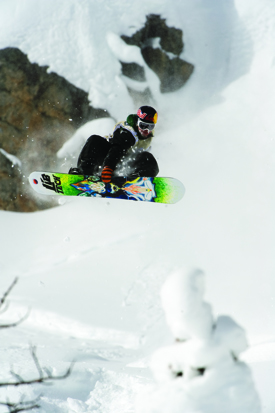
Organization is everything, if it just came down to editing, then you know, bada-bing bada-boom. Sitting and organizing the footage is probably the most tedious part. Curt Morgan, my partner, he started basically in the fall before our second season and kind of worked steadily throughout the winter. We even brought our studio up to Alaska with us for a month. We would shoot during the day and work all night. Then come springtime he pretty much sat down in front of a computer and didn’t leave for four months straight.
What happens with all the unused footage?
We’re doing a six part hour-long TV series. So a lot of it is going toward that.
When will that be ready?
Next fall.
I feel like anyone could watch That’s It, That’s All and enjoy it regardless of whether or not they had ever been snowboarding. Is that what you guys were going for?
That was kind of our big challenge that we put ourselves up to on this project was basically still making the movie for our peers, for the core snowboarder. But, at the same time trying to do it in a sense where a 50-year-old Texan could watch it who has never seen a snowboard and have it be compelling and interesting.
You can’t really appreciate things until you’ve tried them yourself, whether its skateboarding, golf, anything. Until you actually go out and try you don’t really grasp what’s its like or how challenging it really is.
Our big thing was trying to put the viewer in the shoes of the rider.
There is a scene in Alaska where you almost get caught in an enormous avalanche. What was going through your head as you had to “Wolverine” your way out?
Honestly, nothing. You don’t really have time to think about it or process it. It’s action, reaction, you know? It’s more after the fact you actually have time to think about it.
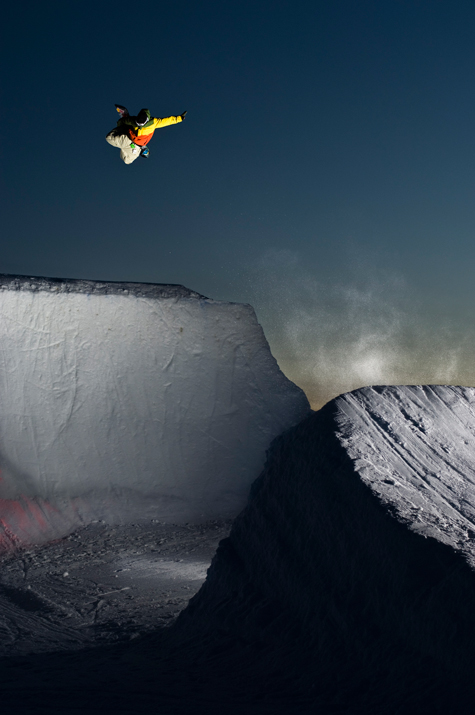
Did that happen often on that trip?
That’s pretty few and far between. That’s only really happened to me three times ever, and that one didn’t even really catch me. It’s definitely uncommon. But, you know, the danger is there, indeed.
There’s a section in the movie where some of your peers are praising you and talking all this great shit about you. What’s it like to hear them say things like, “Rice progresses the sport?”
Oh it’s epic. I couldn’t be happier about it. To be honest, with making this film it’s been a little difficult, especially in the editing process, because it is so focused on me. My buddy put it best when he said to me, ‘The only way this movie is going to be good is if you’re the only one who doesn’t like it.’
[Laughs] No, but I mean it’s definitely humbling.
You are all about progression, you have pushed the sport in new ways your whole career. After That’s It, That’s All, what the hell could be next for Travis Rice?
Oh, it’s in the works, man. In 2010 we’re going to shit all over this project [laughs]. No, ever since we basically had our first premier of this film we’ve been working on a new project. I guess That’s It, That’s All isn’t exactly the greatest title for following it up.

Panic at the Disco Broaden Their Horizons
Las Vegas rock band Panic at the Disco isn’t afraid of change. Even though the band’s 2005 debut, A Fever You Can’t Sweat Out, has topped charts, sold millions of copies worldwide, earned them an MTV video music award for Best Video and sent them on sold-out tours all around the globe, the young group opted not to stick with the same formula for their second release, Pretty. Odd.
“We all kind of felt like we needed a fresh start rather than try to meander our way through stuff that we weren’t 100 percent happy with,” recalled drummer Spencer Smith.
Soon after that realization the band wrote the album’s first single, “Nine in the Afternoon,” a bouncy, psychedelic song that was drastically different than the material that had jump-started their career two years before.
“We were just really excited about it,” Smith said of the new material. “But then we weren’t really sure what anybody else would think.” Regardless of whether or not their fans were going to get it, the band was finally doing exactly what they wanted to do and exactly what they needed to do.
Before embarking on Rock Band Live, Submerge caught up with Smith to talk about plane crashes, turning 21 and eating shit on old school high wheel bicycles.
I’ve read somewhere that way back in the day, before Panic at the Disco, you used to play a lot of Blink 182 covers with Ryan. What are your thoughts on the tragic plane crash that Travis Barker was involved in recently?
Oh, it’s horrible. I was at home and woke up and saw like the front page of Yahoo, I think. It’s pretty amazing that they were able to get out. It was just completely shocking. It was scary obviously because we’re at airports all the time.
Do you guys fly from show to show very often?
Not in the U.S. when we’re on a tour bus, but we just came from Southeast Asia and Australia and there all the places are too far apart, you have to fly. You know, but that’s the thing; those private jets have a lot more chances of things going wrong where if you’re on the bigger ones, they are supposed to be safer. We have ridden in a plane that size though.
Yeah, fuck small planes. On a much happier and lighter note: happy belated birthday. You had one earlier this month right?
Yeah it was on the 2nd [of September], it was my 21st birthday.
Uh-oh, 21? Did you go out and celebrate or have a big party or anything?
Well, it was a couple days after we got back from being on tour for a month. Ryan’s birthday was on Aug. 30, and we were in Auckland, New Zealand, so we didn’t really do anything there. We got home the next day. So yeah, we went out, but we didn’t get too crazy because we were just coming back from a month on tour, you know? So it was good to be like, “Alright, we’re done!” and then just not even do anything for the next five days. But I have been able to go to the grocery store and buy beer [laughs]. Yup, for the first time. So I am pretty excited about that.
Congrats. That’s a big step in life.
Thank you.
I want to talk about your most recent release, Pretty. Odd. It’s been months now since its release and it’s definitely a very different album than your first. How would you say that people have reacted to it overall?
I didn’t really know what to expect during the time we were writing and recording because we all kind of new that it was different. But it was because it had been a couple years since we had really written songs and Jon [Walker] our bass player wasn’t in the band on the first album so writing with him was different. Obviously the music we had gotten into over those two years really changed what we wanted to do.
At least we knew that the songs were coming from the same place, we were just trying to take from our favorite bands at that time. We were writing exactly what we wanted; it was just kind of what we had to do.
I’m sure there are people who love the first album and hate the second record that have no idea why we are even existing anymore.
That’s the nature of music, man; you can never gauge how it’s going to affect somebody, you know?
Yeah. And you and can’t ever please everybody, because if we had written the same record, then we would have had all the people saying, “Oh they just wrote the same record again! That’s boring. Blah, blah, blah.” I guess this way at least, you know, it allows us now to do really whatever we want to do.
You tracked most of the record at home in Las Vegas but did string arrangements and mixed the record at the legendary Abbey Road Studio in London. How was it working there?
It was surprising for us. Rob Mathes, the guy who produced our record, was really passionate about wanting to at least do the strings there. He really likes the musicians there and the way that it sounds in that studio. He had worked there before. And we were like, “Oh man, Abbey Road. That’s cool.” Because, you know, we were able to afford like two days. But then we were trying to find someone to mix the record and we had gone through a couple people who weren’t able to do it, but then [Mathes] brought up this guy Peter [Cobbin] that he had known from working at Abbey Road so many times. We called him up and said, “Alright well, you know, we’re not going to be able to pay you as much as you’re getting paid to do the soundtrack for Lord of the Rings or something, blah, blah, blah.” He was really excited about it. Hopefully we will be able to go back some day and record in there.
I was watching the video for “That Green Gentleman” the other day and noticed that in one scene someone totally eats shit while riding one of those old school high wheel bicycles. Who was that? That kind of looked like it hurt.
That was Jon [laughs] and that was the funniest part of that day. The scene where we are in the boat—it was freezing outside when we were filming. It was so windy and we were sitting out there like, “Fuck, this is horrible.” But then we got on those bikes and the sun came out. We rented them from this company in Hollywood that had just rented a whole bunch of things for the set of There Will Be Blood; they had all this stuff, all these props. So they had these bikes, and they had three or four guys there that kind of knew how to ride them and showed us how to get up on them, but you know, those things didn’t even have brakes.
Yeah, those look gnarly to try and ride.
Yeah and to get off, that’s the hardest thing. To get on isn’t that difficult. Jon though, he ate shit like four times [laughs]. That’s awesome, I’m glad you saw that.
You guys have covered a lot of really rad bands like Smashing Pumpkins, The Band, Radiohead, etc. Are covers something that you guys generally enjoy doing?
Oh yeah, we love it. I don’t know how any band wouldn’t love it. If you’re a musician, you obviously love music, and you’ve got your favorite bands and you listen to music all the time and try to become a better songwriter. But, you know, you get tired of playing your own songs.
Before we are done I want to talk about the Rock Band Live tour coming up. What can fans expect out of your set? Is it going to be a big, elaborate stage show like past tours? Or will it be more stripped down?
I think it will be kind of a mixture. It’s going to be a little bit more similar to the previous tour we did this year, but on a little bit of a bigger level. We’re going to be able to play a couple new songs that we didn’t play before, and we want to learn a new cover song, too. We want to try to do things that we’ve never done live.
